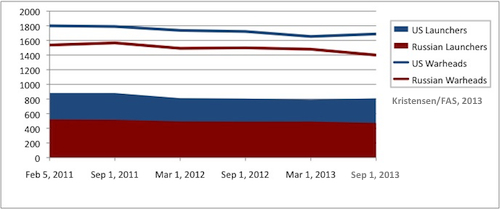New START Data Shows Russia Reducing, US Increasing Nuclear Forces

By Hans M. Kristensen
While arms control opponents in Congress have been busy criticizing the Obama administration’s proposal to reduce nuclear forces further, the latest data from the New START Treaty shows that Russia has reduced its deployed strategic nuclear forces while the United States has increased its force over the past six months.
Yes, you read that right. Over the past six months, the U.S. deployed strategic nuclear forces counted under the New START Treaty have increased by 34 warheads and 17 launchers.
It is the first time since the treaty entered into effect in February 2011 that the United States has been increasing its deployed forces during a six-month counting period.
We will have to wait a few months for the full aggregate data set to be declassified to see the details of what has happened. But it probably reflects fluctuations mainly in the number of missiles onboard ballistic missile submarines at the time of the count.
Slooow Implementation
The increase in counted deployed forces does not mean that the United States has begun to build up is nuclear forces; it’s an anomaly. But it helps illustrate how slow the U.S. implementation of the treaty has been so far.
Two and a half years into the New START Treaty, the United States has still not begun reducing its operational nuclear forces. Instead, it has worked on reducing so-called phantom weapons that have been retired from the nuclear mission but are still counted under the treaty.
For reasons that are unclear (but probably have to do with opposition in Congress), the administration has chosen to reduce its operational nuclear forces later rather than sooner. Not until 2015-2016 is the navy scheduled to reduce the number of missiles on its submarines. The air force still hasn’t been told where and when to reduce the ICBM force or which of its B-52 bombers will be denuclearized.
Moreover, even though the navy has already decided to reduce the missile tubes on its submarine force by more than 30 percent from 280 in 2016 to 192 on its next-generation ballistic missile submarine, it plans to continue to operate the larger force into the 2030s even though it is in excess of targeting and employment guidance.
Destabilizing Disparity
But even when the reductions finally get underway, the New START Treaty data illustrates an enduring problem: the growing disparity between U.S. and Russian strategic nuclear forces. The United States now is counted with 336 deployed nuclear launchers more than Russia.
Russia is already 227 deployed missiles and bombers below the 700 limit established by the treaty for 2018, and might well drop by another 40 by then to about 430 deployed strategic launchers. The United States plans to keep the full 700 launchers.
Put in another way: unless the United States significantly reduces its ICBM force beyond the 400 or so planned under the New START Treaty, and unless Russia significantly increases deployment of new missiles beyond what it is currently doing, the United States could end up having nearly as many launchers in the ICBM-leg of its Triad as Russia will have in its entire Triad.
Strange Bedfellows
For most people this might not matter much and even sound a little Cold War’ish. But for military planners who have to entertain potential worst-case threat scenarios, the growing missile-warhead disparity between the two countries is of increasing concern.
For the rest of us, it should be of concern too, because the disparity can complicate arms reductions and be used to justify retaining excessively large expensive nuclear force structures.
For the Russian military-industrial complex, the disparity is good for business. It helps them argue for budgets and missiles to keep up with the United States. But since Russia is retiring its old Soviet-era missiles and can’t build enough new missiles to keep some degree of parity with the United States, it instead maximizes the number of warheads it deploys on each new missile.
As a result, the Russian Strategic Rocket Forces has begun a program to deploy modified SS-27 ICBMs with multiple warheads (the modified SS-27 is known in Russia as RS-24 or Yars) with six missile divisions over the next decade and a half (more about that in a later blog). And a new “heavy” ICBM with up to ten warheads per missile is said to be under development.
So in a truly bizarre twist, U.S. lawmakers and others opposing additional nuclear reductions by the Obama administration could end up help providing the excuse for the very Russia nuclear modernization they warn against.
Granted, the Putin government may not be the easiest to deal with these days. But that only makes it more important to continue with initiatives that can take some of the wind out of the Russian military’s modernization plans. Slow implementation of the New START Treaty and retention of a large nuclear force structure certainly won’t help.
See also blog on previous New START data.
This publication was made possible by grants from the New-Land Foundation and Ploughshares Fund. The statements made and views expressed are solely the responsibility of the author.
The FY2026 National Defense Authorization Act (NDAA) paints a picture of a Congress that is working to both protect and accelerate nuclear modernization programs while simultaneously lacking trust in the Pentagon and the Department of Energy to execute them.
While advanced Chinese language proficiency and cultural familiarity remain irreplaceable skills, they are neither necessary nor sufficient for successful open-source analysis on China’s nuclear forces.
Satellite imagery has long served as a tool for observing on-the-ground activity worldwide, and offers especially valuable insights into the operation, development, and physical features related to nuclear technology.
This report outlines a framework relying on “Cooperative Technical Means” for effective arms control verification based on remote sensing, avoiding on-site inspections but maintaining a level of transparency that allows for immediate detection of changes in nuclear posture or a significant build-up above agreed limits.